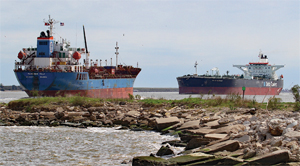The 479-foot Fairchem Filly berthed at the Vopak Terminal on the Houston Ship Channel to offload hexene, a process that required pumping nitrogen into the vessel’s cargo tanks to maintain the chemical’s purity.
Two forward cargo tanks overpressurized early in the offloading process and one tank ruptured, releasing hexene into an adjacent ballast water tank, the National Transportation Safety Board (NTSB) said in a report on the May 30, 2019, incident. No one working at the shoreside terminal or on the ship was injured. No pollution was reported.
The ship, registered in the Marshall Islands, required $750,000 in repairs to the No. 3 port cargo tank and the steel deck on top of the tank that was also damaged. Roughly $100,000 worth of hexene became contaminated.
The NTSB said Fairchem Filly’s crew and Vopak personnel deviated from established practices for cargo discharge, particularly the process of adding nitrogen to “blanket” the hexene. Communication also broke down between ship and shore crews at a pivotal point in the process. As a result, too much nitrogen entered the ship’s No. 3 port and starboard cargo compartments at a rate that exceeded the pressure relief valve’s ability to expel it.
“Since the nitrogen hose connection was improperly configured, the flow rate of nitrogen had to be controlled by the ship or terminal personnel by manually adjusting the dock or ship valve,” the NTSB report said. “Therefore, communication between the ship and terminal personnel was critical.”
Fairchem Filly arrived at the terminal in Deer Park, Texas, at 0400 carrying 65,171 gallons of liquid methyl isobutyl ketone in its 1S (No. 1 starboard) tank. The ship carried 914,563 gallons of hexene in its 2S (No. 2 starboard), 3P (No. 3 port) and 3S (No. 3 starboard) tanks. Hexene must be stored under a “blanket” of inert gas to prevent oxygen absorption. Both chemicals are used in numerous industrial and consumer products.
Not long after arriving, the ship’s crew met with Vopak’s dock supervisor to make plans for the cargo discharge. They completed a safety checklist and coordinated communication over hand-held radios. The NTSB said the crew never completed a separate nitrogen-handling checklist that among other things specified using a 1-inch hose, or using an orifice, to limit nitrogen flows. The terminal’s own safety protocols required hoses no larger than 2 inches in diameter.
Crews used a 4-inch hose, without an orifice, to dispense nitrogen to blanket the hexene during the cargo discharge, which began at about 0700 from the 3S and 3P tanks on Fairchem Filly.
The ship’s cargo tanks had a supply of nitrogen to blanket the hexene during transit, so nitrogen was not needed during the initial cargo discharge. The ship’s nitrogen supply valve was closed, but the shoreside supply valve was about a quarter open.
Low tank pressure alarms sounded 33 minutes after the hexene discharge began. The ship’s crew tried repeatedly to reach the shoreside dockman, who replaced the terminal’s initial contact after his shift ended at about 0600. Surveillance footage later showed the dockman at the break shack when the alarms sounded.
“In an effort to increase nitrogen flow and pressure, the chief officer instructed the pumpman to open the ship’s nitrogen valve, which had been closed,” the report said. “Since the chief officer did not see a change in tank pressure, he instructed the pumpman to fully open the ship’s nitrogen valve, thus making the ship entirely dependent on the terminal’s valve to regulate the flow of nitrogen.”
Ten minutes later another alarm blared, signaling too much pressure in the 3S and 3P tanks. Pressure relief valves for both tanks opened before the crew reported a “surge” on the ship when the 3P tank ruptured. Hexene from that tank overflowed into the adjacent No. 3 port ballast tank, and ballast water overflowed onto the deck through a vent.
The NTSB identified a series of failures that preceded the over-pressurization event. These included the use of an oversized hose to dispense nitrogen into the ship, the communication breakdown that created uncertainty about the condition of the shoreside nitrogen valve, and the chief officer’s order to fully open the ship’s nitrogen valve rather than ceasing the operation until the dockman could be reached.
“Since the (onboard and shoreside) valves were opened too far, the nitrogen supply rate exceeded the tank relief capacity design limit,” the NTSB determined.
The agency added that “both the terminal and operator of the vessel had procedures and control measures in place that clearly outlined a nitrogen blanketing operation, (but) the procedures were not followed on the day of the accident.”
Fleet Management Ltd. of Hong Kong managed Fairchem Filly, built in 2007 in Japan. The company did not respond to an inquiry about the NTSB findings. Vopak, a Dutch chemical giant, did not respond to an email seeking comment.

